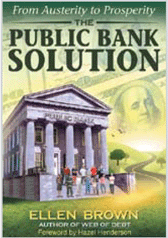Health Insurance for 20 Million is at Risk
If Congress fails to renew the ACA enhanced benefits, millions will be unable to access the health care they need.
Review of The Public Bank Solution: From Austerity to Prosperity by Ellen Brown. Third Millenium Press, 2013.

Banks and bankers are not very popular these days. They made loans they knew homeowners couldn’t possibly repay. Then they cut corners to repossess the homes of people unable to pay their mortgages. Even after they agreed to stop, banks continued these practices (such as robo-signing documents).
Ellen Brown is an attorney by training and President of the Public Banking Institute. The Public Bank Solution argues that problems with the banking industry stem from the nature of private banking and that public banks will solve these problems—by investing in infrastructure and by lending when private banks will not. The first case is easy to make; the latter case is more difficult.
The book begins with an excellent history of money and banks; it then moves to modern times by detailing the rise of central banking, the history of the First and Second Banks of the United States, and the creation of the Federal Reserve in 1913.
Its history of public banks, where state tax revenues fund investment, is first-rate. Most people don’t know that post office banks existed in the United States until 1967 and continue to exist in Japan. Nor do many know about the Bank of North Dakota, which uses state tax revenues to invest in public infrastructure and make loans to local banks.
There are also successful examples of hybrid public-private banks. The Reconstruction Finance Corporation (RFC) provided government loans to banks, railroads and insurance companies during the Great Depression. President Hoover used the RFC sparingly. When Franklin Roosevelt became President in 1933, he used the RFC to make loans to farmers and state governments, and then to finance public-works projects. Industrial banks in Germany aided reconstruction following World War II.
The book ends by explaining our current financial problems and how public banks can help solve these problems. Here it suffers from a number of weaknesses.
First, a minor flaw—it relies too much on blogs, where people can write anything they want, to support its case.
Second, there are a few errors. For example, Brown contends that minting a $1 trillion coin would increase the U.S. money supply without having to rely on the Federal Reserve. Actually, the coin is a gimmick to avoid the folly of debt ceilings—times when Congress passes spending and tax legislation resulting in a revenue shortfall, but then doesn’t let the government borrow money to fund that deficit. Since the U.S. Treasury can mint coins (but not print bills) and deposit them in its bank account at the Fed, a $1 trillion coin would circumvent the dysfunctional politics, letting the government pay its bills, but not necessarily increase the money supply.
Third, there are sins of omission. Surprisingly, the book says nothing about the Home Owners’ Loan Corporation (HOLC). Established during the Depression, this public bank provided government loans at 80% of appraised value for homes worth $20,000 or less ($336,000 today), and helped people stay in their homes by providing assistance in collecting unemployment insurance and even finding tenants. The federal government sold bonds to purchase existing mortgages and refinance them at low rates (1-2 percentage points below market rates). Around 20% of HOLC loans went into foreclosure; the remaining 80% were repaid. All told, the government made a little money.
But the book’s major weakness comes from the fact that Brown oversells public banks. She ignores a quarter-century slump in Japan despite its thriving system of postal banks. Brown points to the BRIC countries (Brazil, Russia, India and China) where public banks play a large role the financial system, as examples of the benefits from public banks. This success, however, is likely the result of capital inflows from the developed world, where interest rates have been near zero. During the summer of 2013, when Fed Chair Ben Bernanke hinted that quantitative easing would soon end, foreign capital rapidly left the BRIC countries and their public banks. Their currencies depreciated, leading to further capital outflows. BRIC public banks began experiencing problems, as did the BRIC economies.
Nonetheless, the basic message of this book is correct and its policy implications are important. Public banks have a successful track record, particularly in the United States, and we should re-institute postal savings accounts, the HOLC, and the RFC. While public banks need to be part of the solution, they are not the entire solution. We must also break up and re-regulate large financial institutions. We should not allow banks to gamble with our money and our economic livelihood.